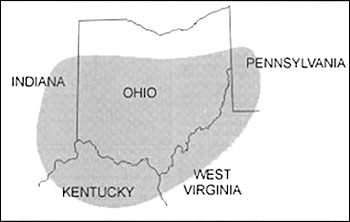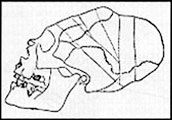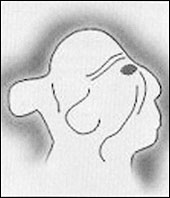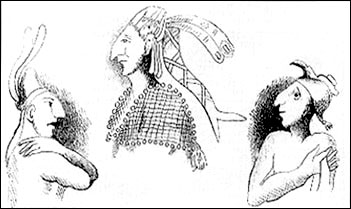Giants and Ancient North American Warfare
|
Per the author's request, his following submission is presented unedited as received, without standard revision for grammar or clarity. As part of our open forum policy, writers may freely express themselves in their own words. Editor.
There are Archaic era mounded structures, often intricate and complex, in the deep southern U.S., including Watson Brake, Poverty Point, Fig Island, and Sapelo. For this reason, theories have been put forth that the moundbuilding tradition came into the Ohio Valley around the time of the Adena from the southern Mississippi, thereby tentatively associating the Adena people with older cultures from the south. In one way of looking at this idea, it supposes that moundbuilding was a phenomenon peculiar to only one geographical source, necessarily having been passed on. Unlike the Adena mounds however, the more ancient southern earthworks did not poignantly suggest a very specialized "cult of the dead."
By their skeletal remains in the earlier studies, the pre-Adena people were known to have had slender or thin bodies, and been "long-headed," with "narrow" skulls (dolichocranic), i.e. having a breadth of skull small in proportion to length from front to back. The Adena people weren't physically akin to these Archaic people. Generally the Adena had more massive bone structure, according to these same studies. The pre-eminent theory of Adena origin at the time was that their ancestry had come from Mexico or even further south. However, the Adena body bone structure type was unusually difficult to trace with surety south of the Rio Grande where another distinguishing Adena-resonant trait was found practiced from earlier times. That practice was "cradleboard" head deformation.
The Adena were, as a group, more "short-headed" (brachycranic), i.e. the skull breadth was at least four-fifths its length from front to back. Shaping was an Non-Adena addition to this already distinguished skull type. This skull-binding of the By their skeletal remains in the
Since few or no other recognizable Mexican-type traits appeared among the Adena grave goods until the centuries-later Adena burials, why, after a many centuries lapse, did the traits indicating Central and South American influence appear in the Ohio Valley? It was beginning to seem that everything distinguishing the Adena, with the possible exception of mounds for the dead, was already in the region for a very long time. It was no longer solid ground to theorize the direct ancestors of the first Adena moving out of Mexico and, after a time, up the Mississippi watershed just because there was skull shaping in ancient Mexico, and earthworks in the deep south.
Popular Theories In about 800 years, and after Adena villages and towns became established throughout what is now Ohio, Indiana, Kentucky, West Virginia, and Pennsylvania, a new stock or breed of people is, by inference, thought to have begun the process of transforming that culture very probably from within. So in a sense, after the Adena seemed to supplant an older culture in the Ohio Valley, another culture succeeded them in relatively linear fashion. Ultimately, this new culture redefined the older Adena. This proposed phenomenon of transformation and replacement characterized what is known as the "Hopewell" era, which term, like Adena and Indian, had been assigned by the inheriting whites. Anthropologists as archaeologists therefore ask these questions. How did the Adena begin, and why did they end, and in the same vein, how and why are they so intimately related to the Hopewell? Why did this supposedly "hybrid" Hopewell culture achieve such distinction and domination over their Adena predecessors, then, like small colonies of the Adena before them, seem to simply fade out from the Ohio valley? The main theory holding interest for many years has been simply that after these round-headed people arrived in the Ohio Valley, they gradually (though not at first) interbred with the existing long-headed people, and over a few centuries slowly generated what we call the Hopewell culture. The Hopewell are believed, though not fully proven, to have evolved agriculture and art further than the Adena, and some of the accomplishments in the latter category amaze us yet today. What has kept our science most intensely interested about the Adena however, is that they constructed mounds for honoring the dead, and were selective about how they went about it. Then, like some sort of magnificent catalyst, the Adena graciously seem to have wandered away, followed into lost history not long after by their believed progeny Hopewell. It should be stated that until now, DNA testing has found no specific match between the Adena-Hopewell and any existing Native American group. Thus has the mystery deepened immeasurably, leaving our anthropological science with its logic, wits, and sometimes questionable carbon-14 analysis. Who were these people? There may be alternative explanations, however conjectural, for the Adena origin and exit. Based first upon the physical analysis, speculations and summations of Webb, Snow, Dragoo, and their colleagues and predecessors, the thoughtful entering of Native American legend into the analysis provides some clear fuel for that soon to be mentioned lamp shedding light on what has too long remained a dim prehistory. As inferred, it is believed that the traits related as Hopewell began to show up around 200 B.C.E. or so. No Hopewell traits have been found in Adena tombs, and thus it has been suggested that Adena chronologically preceded and were culturally anterior to Hopewell. It required some time before the archaeological analysis discerned the Adena as separable from the Hopewell who themselves finally left the region about the middle of the first millennium of the Common Era. It was determined that within just a few centuries after Hopewell began to appear. The purely Adena traits were virtually gone from the Ohio Valley. The Hopewell thus had the valley to themselves for a few hundred years. During this time they yet practiced some limited cradleboard shaping, once almost universal among the Adena. Moundbuilding continued, but changed internally, emphasizing single individuals more. There was evidence of the Adena skeletal type, though in a diminished capacity. Yet artifact evidence of the Adena showed up in points to the south (the Copena Culture), and far to the east, such as the St. Lawrence and Delaware areas, before becoming extinct. The absence of Adena traits in the mounds of the later times ascribed to the Hopewell has prompted a few interesting theories, including a forced exclusion of the Adena by the Hopewell. But this may or may not tell the true story, if we are to rely at all upon the traditional history or legend of a certain elder tribe, who now are called the Lenni Lenape. |
Go Back




